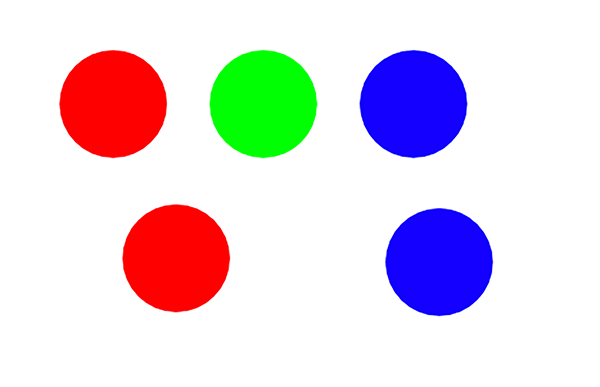single color recognition
Foreword
We live in a colorful world. In this section, we will learn color recognition in machine vision. We will pre-set color thresholds, such as red, green, and blue. This way, the K230 camera can automatically recognize the image after capturing it.
Experiment Purpose
Through programming, CanMV K230 can recognize the color blocks preset by the program, which are red, green and blue.
Experimental Explanation
CanMV integrates the find_blobs function for RGB565 color block recognition, which is mainly based on the LAB color model (each color is represented by a set of LAB thresholds, and interested users can refer to the relevant model information by themselves). It is located under the image module, so we can directly process the captured images. Then, as usual, we look at the description of the objects and functions related to this experiment, as follows:
class find_blobs
Constructors
image.find_blobs(thresholds[, invert=False[, roi[, x_stride=2[, y_stride=1[, area_threshold=10
[, pixels_threshold=10[, merge=False[, margin=0[, threshold_cb=None[,
merge_cb=None]]]]]]]]]])
Find the specified color block in the image. Returns a list of image.blog objects; parameter description:
thresholds: Must be a list of tuples. [(lo, hi), (lo, hi), ..., (lo, hi)] defines the color range you want to track. For grayscale images, each tuple needs to contain two values - the minimum grayscale value and the maximum grayscale value. Only pixel regions that fall between these thresholds are considered. For RGB565 images, each tuple needs to have six values (l_lo, l_hi, a_lo, a_hi, b_lo, b_hi) - the minimum and maximum values of the LAB L, A and B channels, respectively.area_threshold: If the bounding box area of the color block is smaller than this parameter value, it will be filtered out;pixels_threshold: If the number of pixels in a color block is less than this parameter value, it will be filtered out;merge: If True, merge all unfiltered color blocks;margin: Adjusts the edges of merged patches.
Methods
The above function returns an image.blob object.
blob.rect()
Returns a rectangle tuple (x, y, w, h), such as the blob boundary. These values can be obtained by indexing [0-3].
blob.cx()
Returns the center x position of the blob (int). You can get this value by using [5] on the object.
blob.cy()
Returns the center y position of the blob (int). You can get this value by using [6] on the object.
For more usage, please read: CanMV K230 Docs
After understanding the application method of the color block finding function, we can sort out the programming ideas. The code writing process is as follows:
Codes
CanMV K230 mini + 3.5 inch mipi lcd
'''
Demo Name:single color recognition
Platform:01Studio CanMV K230
Tutorial:wiki.01studio.cc
'''
import time, os, sys
from media.sensor import * #Import the sensor module and use the camera API
from media.display import * #Import the display module and use display API
from media.media import * #Import the media module and use meida API
# Color recognition threshold (L Min, L Max, A Min, A Max, B Min, B Max) LAB model
# The following threshold tuple is used to identify the three colors red, green, and blue. Of course,
# you can also adjust it to make the recognition better.
thresholds = [(30, 100, 15, 127, 15, 127), # Red Threshold
(30, 100, -64, -8, 50, 70), # Green Threshold
(0, 40, 0, 90, -128, -20)] # Blue Threshold
sensor = Sensor() #Constructing a camera object
sensor.reset() # reset the Camera
sensor.set_framesize(width=800, height=480) # Set the frame size to LCD resolution (800x480), channel 0
sensor.set_pixformat(Sensor.RGB565) # Set the output image format, channel 0
#Use 3.5-inch mipi screen and IDE buffer to display images at the same time, 800x480 resolution
Display.init(Display.ST7701, to_ide=True)
#Display.init(Display.VIRT, sensor.width(), sensor.height()) ##Use only the IDE buffer to display images
MediaManager.init() #Initialize the media resource manager
sensor.run() #Start the camera
clock = time.clock()
while True:
####################
## Write codes here
####################
clock.tick()
img = sensor.snapshot() # Take a picture
blobs = img.find_blobs([thresholds[0]]) #0, 1, and 2 represent red, green, and blue respectively.
if blobs:
for b in blobs: #Draw rectangles and crosses to represent
tmp=img.draw_rectangle(b[0:4], thickness = 4)
tmp=img.draw_cross(b[5], b[6], thickness = 2)
img.draw_string_advanced(0, 0, 30, 'FPS: '+str("%.3f"%(clock.fps())), color = (255, 255, 255))
Display.show_image(img) # Display image
print(clock.fps()) # FPS
CanMV K230 mini + 2.4 inch mipi lcd
'''
实验名称:单一颜色识别
实验平台:01Studio CanMV K230 mini + 2.4寸mipi屏
教程:wiki.01studio.cc
'''
import time, os, sys
from media.sensor import * #导入sensor模块,使用摄像头相关接口
from media.display import * #导入display模块,使用display相关接口
from media.media import * #导入media模块,使用meida相关接口
# 颜色识别阈值 (L Min, L Max, A Min, A Max, B Min, B Max) LAB模型
# 下面的阈值元组是用来识别 红、绿、蓝三种颜色,当然你也可以调整让识别变得更好。
thresholds = [(30, 100, 15, 127, 15, 127), # 红色阈值
(30, 100, -64, -8, 50, 70), # 绿色阈值
(0, 40, 0, 90, -128, -20)] # 蓝色阈值
sensor = Sensor(width=1280, height=960) #构建摄像头对象
sensor.reset() #复位和初始化摄像头
sensor.set_framesize(width=640, height=480) #设置帧大小为2.4寸屏分辨率(640x480),默认通道0
sensor.set_pixformat(Sensor.RGB565) #设置输出图像格式,默认通道0
Display.init(Display.ST7701,width=640, height=480, to_ide=True) #同时使用3.5寸mipi屏和IDE缓冲区显示图像,800x480分辨率
#Display.init(Display.VIRT, sensor.width(), sensor.height()) #只使用IDE缓冲区显示图像
MediaManager.init() #初始化media资源管理器
sensor.run() #启动sensor
clock = time.clock()
while True:
################
## 这里编写代码 ##
################
clock.tick()
img = sensor.snapshot() #拍摄一张图片
blobs = img.find_blobs([thresholds[0]]) # 0,1,2分别表示红,绿,蓝色。
if blobs:
for b in blobs: #画矩形和箭头表示
tmp=img.draw_rectangle(b[0:4], thickness = 4)
tmp=img.draw_cross(b[5], b[6], thickness = 2)
img.draw_string_advanced(0, 0, 30, 'FPS: '+str("%.3f"%(clock.fps())), color = (255, 255, 255))
Display.show_image(img) #显示图片
print(clock.fps()) #打印FPS
Experimental Results
When running the code in CanMV IDE, the code detects red by default. Users can modify the threshold array number of the find_blobs() parameter to switch the recognition color, as follows:
Red identification:
Original image:

Identification results:

In this section, we learned how to implement single color recognition on CanMV K230 through MicroPython programming. This experiment is mainly based on the LAB color model. Interested friends can refer to the relevant information of the LAB module by themselves, and then combine the printing threshold to view its tuple data for in-depth learning. You can also find a variety of irregular shaped color objects for comparison and learning.